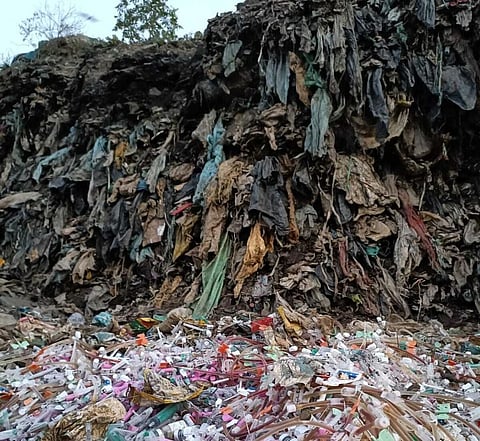Is India prepared to manage its burgeoning medical waste challenge?
Ineffective management of medical and biohazardous waste or accidents at any stage, from generation to disposal, have the potential to cause serious ecological consequences. The Biomedical Waste Management Rules, 2016 was envisioned to strengthen India’s regulatory and compliance framework for safe disposal and handling of such waste.
The COVID-19 pandemic exposed major systemic drawbacks, with data management, improper reporting and poor segregation awareness emerging as pressing concerns. Even after the pandemic, there have been multiple news of healthcare facilities (HCF) and Common Biomedical Waste Treatment Facilities (CBWTF) across the country flouting the rules.
The state pollution control boards and committees issued 15,355 show-cause notices / directions to defaulter facilities, according to the Central Pollution Control Board’s (CPCB) annual report on biomedical waste management for 2021.
Recently, CPCB collated all submissions by state pollution control boards and committees and presented a report complying with the National Green Tribunal’s order dated January 12, 2024. As per the numbers provided by the 36 pollution control bodies, there are 393,242 HCFs in the country. Around 67.8 per cent of HCFs are non-bedded – clinics, laboratories, blood banks, dispensaries, veterinary institutions, among others.
The remaining 32.2 per cent are hospitals, nursing homes and other healthcare facilities where beds are available. As many as 156,540 HCFs have authorisation from the SPCBs / PCCs, while the rest are in the process of getting the requisite authorisation. Uttar Pradesh, Karnataka and Bihar have the highest numbers of HCFs, where authorisation is pending.
Generation-treatment gap
About 79 per cent of the total HCF are currently using services of the 218 operational CBWTFs for treatment and disposal. Chandigarh, Goa, Haryana, Himachal Pradesh, Madhya Pradesh and Telangana have reported that the available capacity of CBWTFs is adequate and no additional facility is required.
Assam, Rajasthan, West Bengal and Delhi have reported that they are in the process of setting up additional CBWTFs. Odisha, Kerala and Bihar have reported that a gap analysis study is under process.
Andaman & Nicobar Islands, Arunachal Pradesh, Lakshadweep, Mizoram, Nagaland, Sikkim and Ladakh are without CBWTFs. As many as 206 HCFs operating in Daman & Diu and Dadra & Nagar Haveli transport their waste to facilities in Gujarat. Presently, 34 new CBWTFs are under construction across the country.
India generates around 700 TPD of biomedical waste approximately and about 640 TPD is treated, despite the combined treatment capacity available being 1,590 TPD. The reported installed incineration capacity is 857 TPD and autoclaving capacity is 752 TPD.
Despite having a surplus capacity, 20 states other than the seven mentioned above without CBWTFs are still using captive treatment measures and deep pit burials for disposal.
As per the submissions by SPCBs, 208 out of 218 CBWTFs have adopted the Centralised Bar Code System for Tracking Biomedical Waste (CBST-BMW) and installed the Online Continuous Emission Monitoring System (OCEMS) and are using it.
The CPCB recommended all SPCBs a time-bound authorisation of HCFs, limiting the use of captive treatment facilities, vigilant monitoring of OCEMS, training and capacity building of all healthcare workers and strict compliance with the BMW Rules, 2016.
Way forward
India’s biomedical waste management market is expected to grow at a compound annual growth rate of 7-8 per cent. The quantum of waste generated is expected to be troublesome if the gaps and leakages are not managed.
All SPCBs need to conduct the gap analysis to estimate the leakages and use their discretion, so newer CBWTFs can be constructed and their operational radius can be determined.
Elaborate probing is required to check the actual vs reported capacities and the system's compliance with the mandated rules. Authorisation of HCFs and strict monitoring of OCEMS needs to be done. All stakeholders from the user to the occupier to the processors need to be tracked so any premeditated leakages can be avoided.
Multiple gaps exist in the present system and there have been complaints about illegal transfer of waste, improper incineration and disposal methods. It is evident that, some CBWTFs are catering to a very large number of HCFs within their hinterland.
But today, India has 806 districts and building a facility for every district in India is practically and financially not viable. The SPCBs need to figure out the correct number of facilities, proprietors and techniques required to cater for the waste generated.
The ambit of barcoding should be extended to the recyclers of biomedical waste, so there is a check on the manufacturing, distribution and consumption of those recycled products. Hospitals generate large amounts of non-medical waste such as paper, plastics and food waste, and there have been instances of biomedical and municipal solid waste being mixed at the source, so the provisions in the Solid Waste Management Rules, 2016 for bulk waste generators have to be made more specific for HCFs. The idea is to challenge the setbacks in the system so that, no form of medical or bio-hazardous waste reaches any of India’s dumpsites.


